Top 10 Must-Visit Places in Jaisalmer’s Desert
So much to see in Jaisalmer, Rajastan
The golden city of Jaisalmer in Rajasthan India rises out of the Jaisalmer desert like a mirage, its magnificent sandstone architecture and surrounding desert conjuring up images of camel trains across endless sand dunes, fierce Rajput warriors, exotic princesses and towering desert fortifications.
Jaisalmer has a long and turbulent history and rich cultural heritage, and the imposing Jaisalmer Fort which stands above the city is an absolute must see on any visit in Jaisalmer. But while Jaisalmer Fort is definitely Jaisalmer’s most iconic tourist destination, there are a lot more places to visit around the Jaisalmer district than just the fort and the city.
Below is a list of the top 10 places to visit in Jaisalmer.
1. Sam Sand Dunes

First in our top 10 places to see in Jaisalmer is Sam Sand Dunes, which are located around 40 km from the desert city, and which are one of the most popular places to visit in the district. Their awesome sun baked beauty makes them a must visit during any trip to Rajasthan.
If your imaginings take you to a desert with golden sand dunes and camel safaris trekking across an ancient network of trading routes along the old silk road to India, Turkey and beyond, then the Sam Sand Dunes Jaisalmer are a place you must visit.
Where once camels carried Maharajas, Rajput warriors, traders and precious cargo, they now offer visitors the chance to get away from the hustle and bustle of the city and ride across the desert, experiencing the same awesome immensity, windswept horizons and ancient Rajasthani hospitality as travellers did so long ago.
Camel safaris and desert camps have been a mainstay of life in the Thar Desert for eons, and today remain an essential part of the Jaisalmer desert experience.
The golden dunes of the Sam Sand Dunes are undeniably among the most picturesque in India, stretching in places to the height of 60 meters across a stark and arid landscape. The Sam Sand Dunes are renowned for their spectacular sunsets and starry nights, which create a magical atmosphere across the golden wind swept sands of the desert.
Not only do visitors have the opportunity to explore the vast desert landscape and witness its breathtaking beauty. The dunes are also an adventure lover’s paradise. There are plenty of entertaining activities, like going on a camel safari, jeep safari, half or full day desert tour, dune bashing adventure or quad bike riding, or camping out under the stars.
Staying overnight in a luxury desert camp near the dunes offers a great place to arrange and travel out from to undertake these activities, as well as the opportunity to return to comfortable accommodation in the desert camp, delicious local food, and cultural entertainment with music and dancing.
Queen of Thar is one of the best desert camps in Jaisalmer and is located right beside Sam Sand Dunes. As well as a variety of desert tours and activities, it offers a friendly and comfortable night’s accommodation as well as a captivating experience of Rajasthani desert culture and hospitality.



You can also read more about the history of the area where Rajput warriors and Maharajas journeyed of old here
Travelling across the sands of the desert on camel safari and staying in a luxury Jaisalmer desert camp can be amongst the most beautiful and memorable experiences a traveller can have. Maharajas, Maharanis, traders and travellers alike have been visiting the sands of Thar Desert in Rajasthan since time immemorial.
The Sam Sand Dunes and Queen of Thar Desert Camp are located around 45 minutes drive from Jaisalmer Fort.
2. Bada Bagh- Bagh of Royal Grandeur
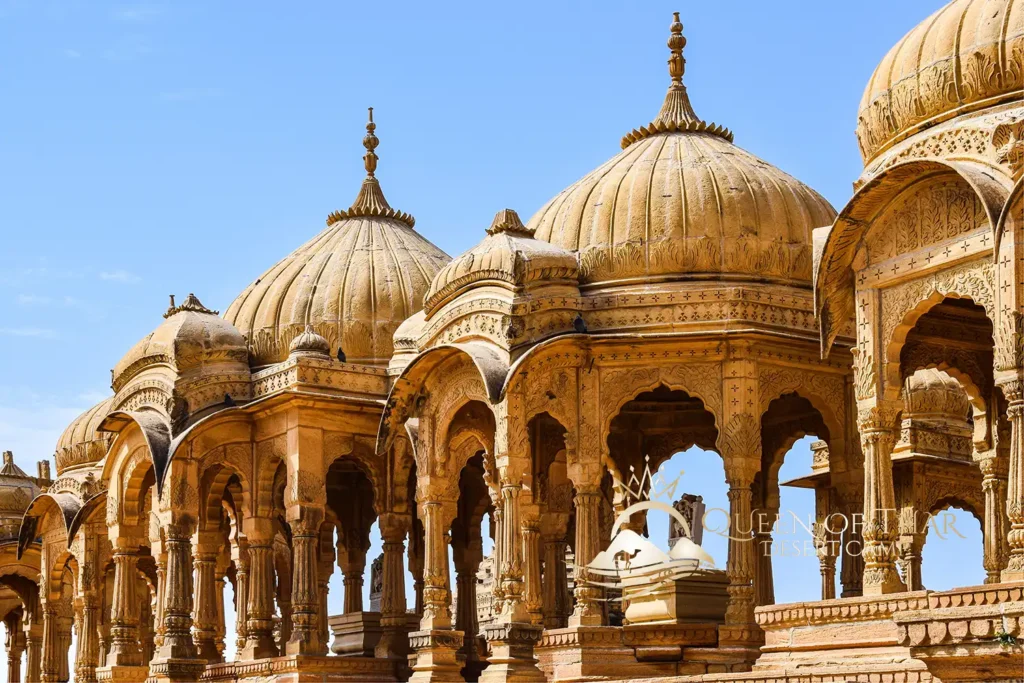


Bada Bagh is the next on this list of best places to visit in the Jaisalmer desert. Bada Bagh is a historical garden complex built by the Maharajas of Jaisalmer from the 16th century to honour their ancestors. It is famous for its golden sun-baked cenotaphs which are enchantingly beautiful, especially at sunrise or sunset when the sun’s rays turn them to a rich honey gold.
The Bada Bagh cenotaphs are made of yellow sandstone, which is widely available in the region and a feature of much of Jaisalmer architecture. They feature exquisite carvings and designs that reflect both the Islamic and Hindu influences which were incorporated into Rajput architecture at that time. The style of architecture used in the construction of the cenotaphs is a visual feast for the eyes, featuring domes, arches and pillars that are typical of Islamic buildings, as well as intricate carvings and ornamentation that are characteristic of Hindu architecture, with carvings of Hindu gods and goddesses, as well as scenes from Hindu mythology.
The first cenotaph was built by Maharaja Lunkaran to commemorate the death of his father, Maharaja Jai Singh II, the founder of Jaisalmer and the man who commissioned the dam (Jait Bandh) near Bada Bagh to collect and store water to help cultivate the desert land.
Bada Bagh is one of the essential places to visit in Jaisalmer. it is a photographer’s dream, providing a feast of opportunities to capture stunning images. The intricate carvings on the cenotaphs, the contrast of the golden sand dunes against the blue sky, and the vibrant colours of the local Rajasthani attire are enormously photogenic.
Bada Bagh is located around 8 km from Jaisalmer Fort and a visit is included in the Queen of Thar desert tour.
3. Amar Sagar




Amar Sagar is next on our list of best places to visit in Jaisalmer.
Amar Sagar is a small and beautiful oasis, originally built as a water reservoir for the golden city in the 14th century. Today it is a small lake surrounded by gardens and pavilions that offer a scenic view of the lake and the desert, as well as a Jain temple and a palace.
The best time to visit the lake is often thought to be the golden hours of sunrise or sunset, but in truth Amar Sagar is a welcome retreat at any time of the day, particularly after travelling across the arid expanses of Sam Sand Dunes or Thar Desert National Park.
At the lake a series of steps take visitors to the Amar Singh Palace, a grand palace built by Maharawal Akhai Singh in the 17th century next to the lake, and which is known for its impressive architecture. The palace boasts intricate carvings, balconies, and jharokhas (overhanging enclosed balconies), showcasing a blend of Rajput and Mughal architectural styles. The palace offers panoramic views of the surrounding area and is a notable historical attraction.
The Amar Sagar lake is also overlooked by a Jain temple (called Adeshwar Nath Jain Temple), built by Patwa Bafna Himmat Ram in 1928. The temple is dedicated to Lord Parshwanath, the 23rd Tirthankara of Jainism. The temple has beautifully carved pillars and various figurines of animals and Tirthankaras inside. It is a serene and sacred place to visit.
Stepwells like at Amar Sagar are a traditional and ancient water storage structure found in regions with scarcity of water. It features a series of steps or ledges that descend into the water, allowing people to access the stored water at different levels. These wells often showcase architectural and artistic elements, serving both functional and aesthetic purposes.
Amar Sagar is an another not to be missed destination for anyone who wants to explore Jaisalmer’s surrounds and admire its spectacular golden architecture. It can be visited via a short drive from Jaisalmer city or on a private tour
4. Lodrawa


Lowdra is the next in our list of our best places to visit in Jaisalmer. Lodrawa (aka Lodurva, Lodarva or Laudrava) is a village located around 15 km to the north-west of the Jaisalmer Fort.
Lodrawa was the ancient capital of Jaisalmer during the Bhati dynasty, from the 8th century until 1156 CE. The city stood on an ancient trade route through the desert, which made it valuable but vulnerable to frequent attacks by foreign invaders. This eventually led to its abandonment and established in new capital and fort by Rawal Jaisal, 16 km away on the more secure Trikuta Hill where Jaisalmer Fort stands today.
Though its glory days as the capital are long behind it, Lowdra remains highly regarded as one of the best places to visit for its sandstone and limestone Jain temples, as well as for being the setting for the tragic Rajput love story of Princess Mumal and Prince Mahendra.
Rajasthan’s own Romeo and Juliet love story

The tragic love story of Rajput Prince Mahendra and Princess Mumal is part of local folklore.
Legend has it that Moomal and Mahendra were lovers from different kingdoms. Moomal was a princess of Lodrawa and Mahendra was a prince of Umerkot, in present-day Pakistan. They met at her palace, which was known as Kak Mahal, and fell in love.
Mahendra used to visit the love of his life Moomal every night by riding his fast camel, Cheetal, from Umerkot to Lodhruva every evening and returning by morning. But one day his family found out and broke the camel’s legs. Mahendra took another camel, but lost his way.
Moomal, thinking that Mahendra had abandoned her, set fire to her palace and died in the flames. Mahendra, when he learned of her death, also killed himself. Their tragic love story is immortalized in a popular Rajasthani folk song and ballad.
The Lodrawa Jain temples
The Lodrawa temples are considered some of the finest examples of Jain architecture in Rajasthan, famous for their intricate craftsmanship and stone carvings.
There are 4 temples – Lodhurva Parshvanath Temple, Rishabhnath Temple, Ajitanath Temple, and Shambhavanath Temple; all dedicated to Jain Tirthankaras.
The temples are built in the Maru-Gurjara style of architecture, and are decorated with intricate carvings and sculptures. The most prominent temple is the Parshvanath Temple, with its delicate examples of filigree art, dedicated to the 23rd Tirthankara of Jainism. The temple displays a unique ornate ceiling that preserves a beautiful sculpture of a four-bodied demon, dedicated to the 22nd Tirthankara. A large number of peacocks live around the temples, adding colour and beauty to the landscape.
The original temples were destroyed by Muhammad Ghori in 1178 CE when he swept east into modern day Rajisthan, setting the stage for the establishment of Muslim rule in North India and eventually leading to the formation of the Delhi Sultanate. But the temples were rebuilt in the 17th century with the exquisite carvings and architecture now on display.
Lodrawa can be visited via a short drive from Jaisalmer city or on a private half or full day tour
Jainism in Rajasthan
Jain temples feature large in Jaisalmer, in fact Rajasthan has the highest number of Jain temples in India, with more than 6000 temples.
Jainism is one of the oldest religions in India, with a history that dates back to at least the 6th century BCE. Rajasthan has had a close historical connection with Jainism, which flourished in Rajasthan under the patronage of various Rajput dynasties who ruled over different regions of the state from the 8th to the 13th centuries CE. These rulers supported the construction of many magnificent Jain temples.
Some of the most famous temples in addition to the Lodhurva Jain temples are the Dilwara temples near Mount Abu, the Ranakpur Jain Temple, the Soniji Ki Nasiyan in Ajmer (also known as the Golden Temple) and the Shri Mahaveerji Temple in Hindaun.
Though Jainism faced persecution and decline in Rajasthan during the 14th and 15th centuries CE due to the invasions of the Mughal Empire which destroyed many Jain temples and monuments, it revived in Rajasthan in the the 16th century and 17th centuries CE and today continues to be a significant religion in Rajasthan, with about 1.2 million followers, or 1.4% of the state’s population.
Jainism teaches the principle of nonviolence and respect for all living beings. There is a nice story regarding Alexander the Great who campaigned into north-west India in the 4th century BCE. When Alexander asked a group of Jain philosophers why they were paying so little attention to the great conqueror, they were reported by Arrian as replying: “ King Alexander, every man can possess only so much of the earth’s surface as this we are standing on. You are but human like the rest of us, save that you are always busy and up to no good, travelling so many miles from your home, a nuisance to yourself and to others! … You will soon be dead, and then you will own just as much of the earth as will suffice to bury you.”
5. Desert National Park, Jaisalmer

The Desert National Park Jaisalmer is a national park situated near the towns of Jaisalmer and Barmer. This is one of the largest national parks covering an area of around 3,000 KM, and was set up as a protected area to conserve and protect the unique desert ecosystem and its diverse wildlife.
The region is extreme hot and arid, with very low rainfall. It is well known for its extraordinary landscape, with its shifting sand dunes, rocky terrain, and sparse vegetation. Sand dunes form around 44% of the Park. It is part of the huge Thar Desert which is often called an ‘ocean of sand’ covering over 200,000 sq km.
Visitors appreciate the natural beauty of this arid landscape, its wildlife and its fragile ecosystem. The park is renowned for its conservation efforts to protect the fragile desert ecosystem. Visitors can experience the beauty of the Thar Desert, witness wildlife in their natural habitat, and explore ancient fossilized riverbeds. It offers a distinctive desert experience and is a haven for nature enthusiasts and wildlife lovers.
Flora and Fauna

The vegetation of the desert is quite sparse, with sand dunes and open grassland, thorny bushes, and Khejri (also known as shami in Rajasthan), an amazingly hardy, frost and drought-resistant tree that has been a symbol of survival in the harsh Rajasthan desert.
Khejri is one of the ingredients of the local dish ker sangri – One favourite local food is ker sangri, a simple dish of just five ingredients, which are all available in the Thar Desert. Ker is a small, tangy berry that grows on a thorny shrub, the ker tree. And sangri are thin, bean-like pods of the khejri tree.
Arid as it is, there is a surprising amount of birdlife, with the region being a haven for both migratory and resident desert birds. Eagles, falcons, buzzards, kestrel and vultures can all be spotted here, with the most common subspecies being short-toed eagles, tawny eagles, spotted eagles, laggar falcons and kestrels. The endangered Great Indian bustard can also been seen here.
In adition to the bird life, some of the Desert National Park is home to other notable inhabitants like the Indian Gazelle, the desert fox, blackbucks, chinkaras, the wolf and desert cat.
The Desert Fox
The desert fox is a good example of a subspecies that is uniquely adapted to arid desert environments like this. It is a subspecies of the red fox and can be found in throughout the desert region, including the areas surrounding Jaisalmer.
The sandy dunes and sparse vegetation of the desert provide a suitable habitat for the fox, which has distinct physical features that help it survive in the challenging environment. It has a sandy coloured fur coat that provides camouflage against the desert sands. Its large, sensitive ears help dissipate heat and aid in detecting prey and potential threats. Like camels, the desert fox also has specialised fur on its paws, which protects them from extreme temperatures and allows for efficient movement on the hot desert sand.
For more information about the desert, see: Thar Desert 101: everything you need to know
How and when to visit
To visit the Desert National Park a permit needs to obtained from the park authorities.
The best time to visit Desert National Park is in the winter months of October to February when the days are pleasant and the nights are cool. The summer months of April to June are extremely hot, and therefore not advisable for a visit to the desert.
6. Kuldhara

Kuldhara (Kuldhera) is an abandoned village with a mysterious past.
The village was established in around the 13th century CE by the Paliwal Brahmins. They were a prosperous community of farmers and traders who migrated from Pali. They developed a unique system of irrigation and farming in the desert and built many beautiful temples and houses.
However, despite their flourishing community, in the early 19th century CE they suddenly abandoned the village and the surrounding villages almost overnight for unknown reasons.
Why was Kuldhara abandoned?
According to one local legend, the abandonment was triggered by the actions of the tyrannical Rajput ruler Salim Singh (dubbed the monster of Jaisalmer) who took a keen but unwelcomed interest in the young daughter of Kuldhara’s chief. The villagers, unwilling to give up the frightened girl, banded together and decided to abandon the village without notice and flee to prevent him from taking her. Before leaving, they supposedly placed a curse on the village so it would remain uninhabited forever. Thanks to the curse, anyone who tried to settle there after their departure would be doomed to misfortune and ultimately, failure.
Another local legend says the villagers were cursed by a sorcerer who was angry with them for not paying him his dues. Others say a drought or earthquake was responsible.
Whatever the reason, the fleeing villagers are believed to have left behind a curse ensuring that no one can ever live in Kuldhara again. Since then, the village has remained deserted and haunted and is considered one of the most spooky places in India.
Kuldhara Today
Visitors can see the ruins of the houses, the temple, the wells, and the cenotaphs in the village, still standing as they were abandoned 200 years ago. You too will feel the eerie atmosphere of the ghost town, and like the many people who have visited it over the years, experience the mystery and the legend of the Paliwal Brahmins.
Kuldhara is around 18 km away from Jaisalmer Fort and can be visited as part of a desert safari.
7. Khaba Fort Ruins
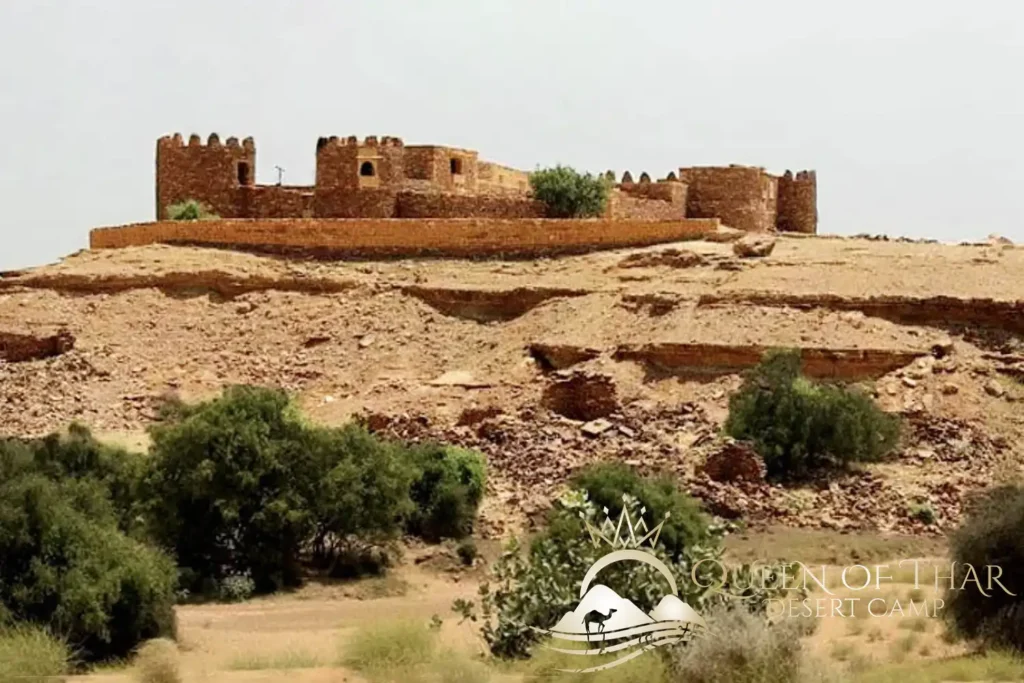

Around 20 km away from Kuldhara on the top of a small hill overlooking the desert and an abandoned village is the Khaba Fort ruins.
Khaba Fort was built back in the 14th century AD and was once an important part of the Kuldhara region. It was used as a defensive structure and a Sarai Fort. A Sarai Fort is a type of fort that was built by the Mughals as a resting place for travellers, traders and soldiers. Sarai Forts usually had a large courtyard, surrounded by rooms, gates, and towers. A Sarai Fort also provided facilities such as water, food and security.
Like Kuldhara, the village below the fort had been inhabited by Paliwal Brahmins, who suddenly abandoned the village and the fort 200 years ago. Desert winds have been ravaging the abandoned fort and village since that time, but the crumbling structure of the fort still looks out over the ruins of Khaba village.
The fort itself is a small structure, built of sandstone and featuring carvings and paintings. The fort also has a museum, which displays some artefacts and photographs from the village and its history.
The fort offers a stunning view of the desert landscape and the nearby villages. It is a place to visit on a desert safari, and where you can feel the mystery and the legend of the Paliwal Brahmins, and wonder what made them leave their homes so abruptly. A drought, a curse, a cruel minister?
The Khaba Fort ruins are located about 45 km away from Jaisalmer city, and 25 km away from Sam Sand Dunes.
8. Longewala War Museum
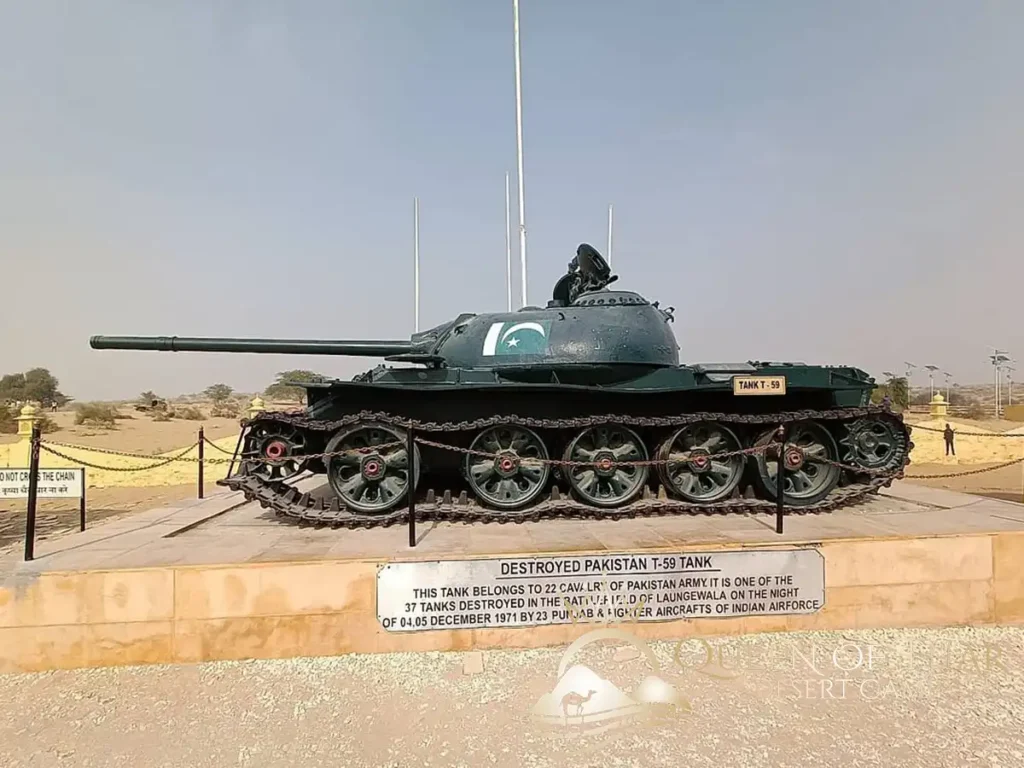


The Longewala War Museum is located near the border between India and Pakistan, about 150 km away from Jaisalmer Fort, deep in the heart of the desert. It is regarded as one of the best places to visit in Jaisalmer Rajasthan.
The museum showcases the history and heroism of the Battle of Longewala, which was a gripping battle fought between the Indian Army and the Pakistan Army in December 1971. The Battle of Longewala was one of the major decisive battles fought during the 1971 India – Pakistan War.
The Battle of Longewala
The battle was fought between 2,000–3,000 Pakistani soldiers accompanied by 30–40 tanks and a medium artillery battery, and 120 Indian soldiers, subsequently reinforced by four Hunter fighter aircraft.
The Pakistani forces began their attack at 12:30 AM on the night of 4 December 1971. As the offensive approached the lone outpost, the Pakistani artillery opened up across the border with medium artillery, killing five of the ten camels from the border security force detachment. The 120 Indian soldiers at the border post dug in and defended the post, and in spite of massively outnumbering the Indian defenders, the Pakistani troops were unable to advance over open terrain on a full-moon night, under small arms and mortar fire from the outpost.
As the sun rose at the dawn of 5 December 1971, help for the post came in the form of Hunter jets from the base at Jaisalmer, which wreaked havoc on the Pakistani troops. By noon after heavy losses the assault was over, with Pakistani losses including 6 tanks destroyed or abandoned, 500 additional vehicles lost and around 200 soldiers killed, thwarting the advance of the Pakistani army in its tracks.
The battle is known for its unparalleled display of courage and resilience by a small Indian contingent and many people visit Longewala War Museum to view the display of military equipment, photographs and artefacts from the battle, as well as an audio-visual room, and honour the brave defenders.
The Battle of Longewala has been memorialised in the 1997 Bollywood film Border.
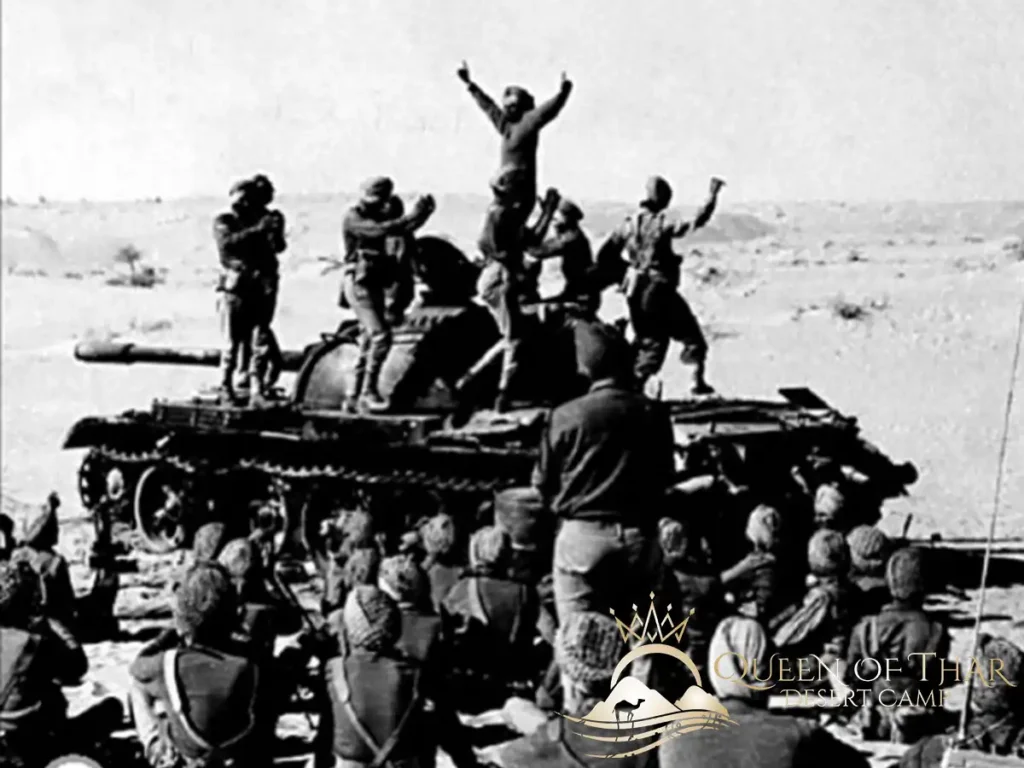


What to see at Longewala War Museum
The memorial complex comprises a museum, a gallery, and military equipment used during the battle.
Upon entering the memorial, visitors are greeted by the heroic tale of the Battle of Longewala through vivid displays, photographs and artefacts. The museum showcases weapons, uniforms, personal belongings, and other remnants from the war, offering a profound insight into the hardships soldiers face on both sides.
The memorial proudly displays the famous T59, Sherman tanks and other military equipment used in the battle, keeping the memory of that historic event alive.
How to get there
The Longewala War Museum is located near the border between India and Pakistan, about 150 km away from Jaisalmer city or around 125 km (2 hours) away from Sam Sand Dunes where Queen of Thar is located. You can drive or hire a taxi to reach the museum.
The Jaisalmer War Museum
Those with an interest in military history should also visit the Jaisalmer War Museum, which is located on the eastern outskirts of Jaisalmer. The Jaisalmer War Museum is spread over an area of approximately 1 acre and displays various war exhibits, including equipment and vehicles captured during 1965 and 1971 operations and a Hunter aircraft which destroyed enemy tank columns during the Battle of Longewala.
9. Tanot Mata Temple
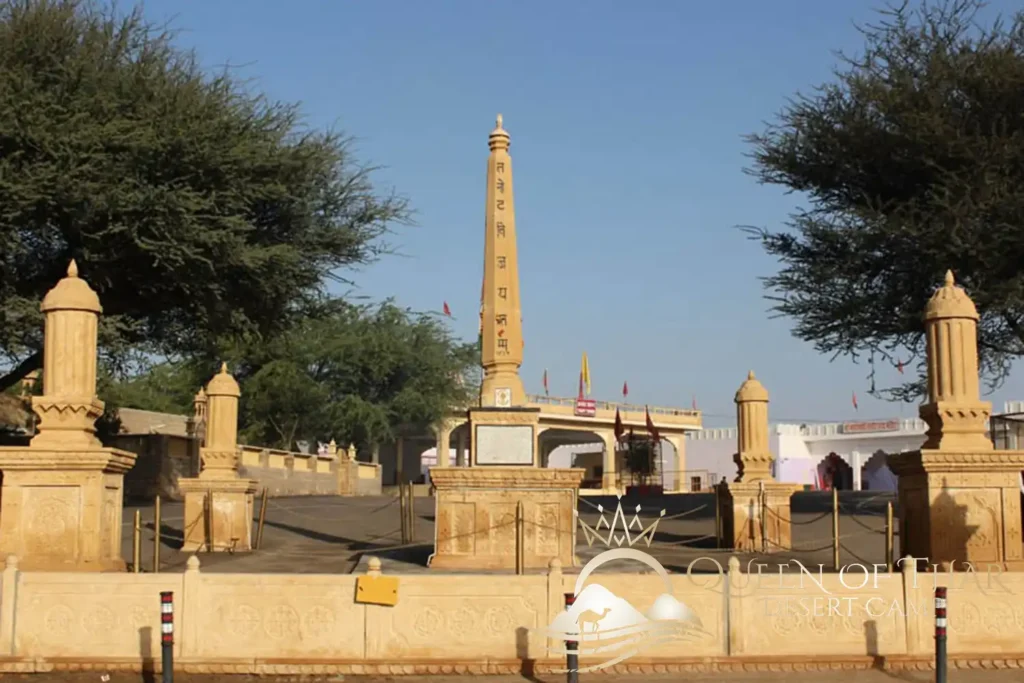
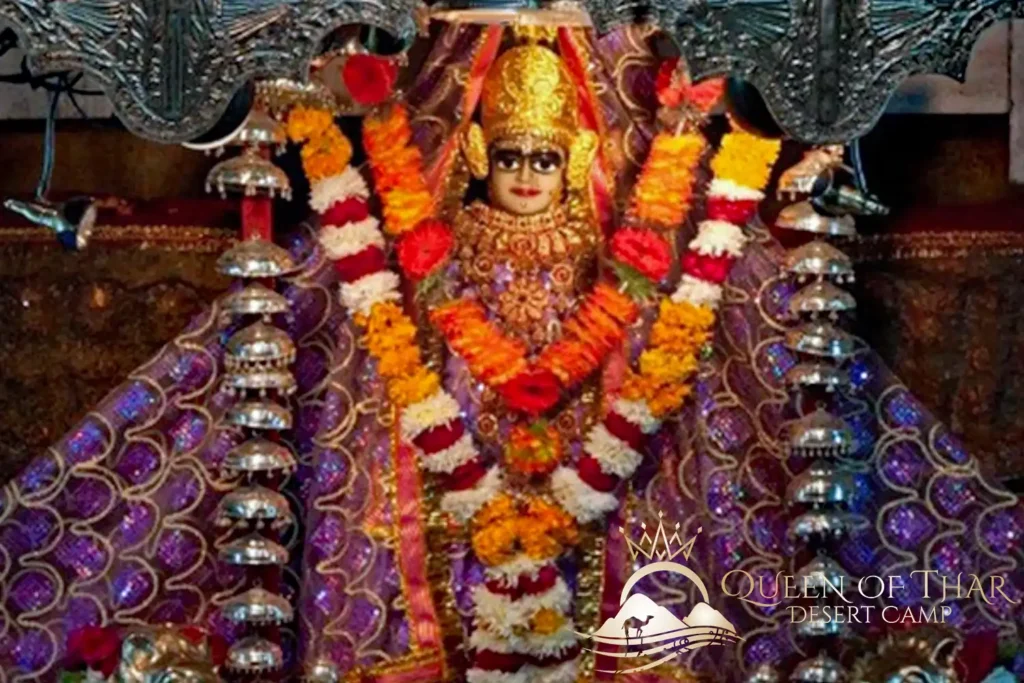
The Tanot Mata Temple is a religious and historical site, located very near the India-Pakistan border, deep in the Thar Desert in Jaisalmer Rajasthan, around 38 km away from Longewala and 120 km away from the Jaisalmer Fort. The temple was constructed by the Rajput King Tanu Rao in the 9th century CE and has been revered by the Bhati Rajputs and the people of Jaisalmer ever since.
The temple is dedicated to Tanot Mata, a Hindu goddess who is worshiped as an incarnation of Hinglaj Mata, the goddess of war, and considered as the predecessor of Karni Mata, another famous goddess of Rajasthan and an incarnation of Durga, the warrior goddess.
The goddess is believed to have miraculous powers. The temple was heavily bombarded in the 1965 India-Pakistan war, but none of the bombs that dropped around the temple exploded. It was attacked again during the 1971 India-Pakistan war, but again survived unscathed. Contemporary folklore credits the temple for the outcome of the battle.
After the war, the temple was handed over to the Border Security Force of India which continues to manage the temple. The Indian army built a Vijay Sthamba within the temple premises as a war memorial, and every year in December a celebration takes place to commemorate the victory of India over Pakistan. Some of the bombs are on display at the adjoining museum, which houses artefacts from the time of war.
Like Longewala, Tanot is famous for its portrayal in the popular Bollywood movie Border.
Tanot has become one of most visited tourist spots especially for those who love the wilderness of Rajasthan and admire stories related to army heroics. Along with faith and devotion, the temple is also a symbol of strength and courage. Many feel the temple has an aura to feel the presence of the holy deity, which has protected Tanot until today.
10. Gadisar Lake

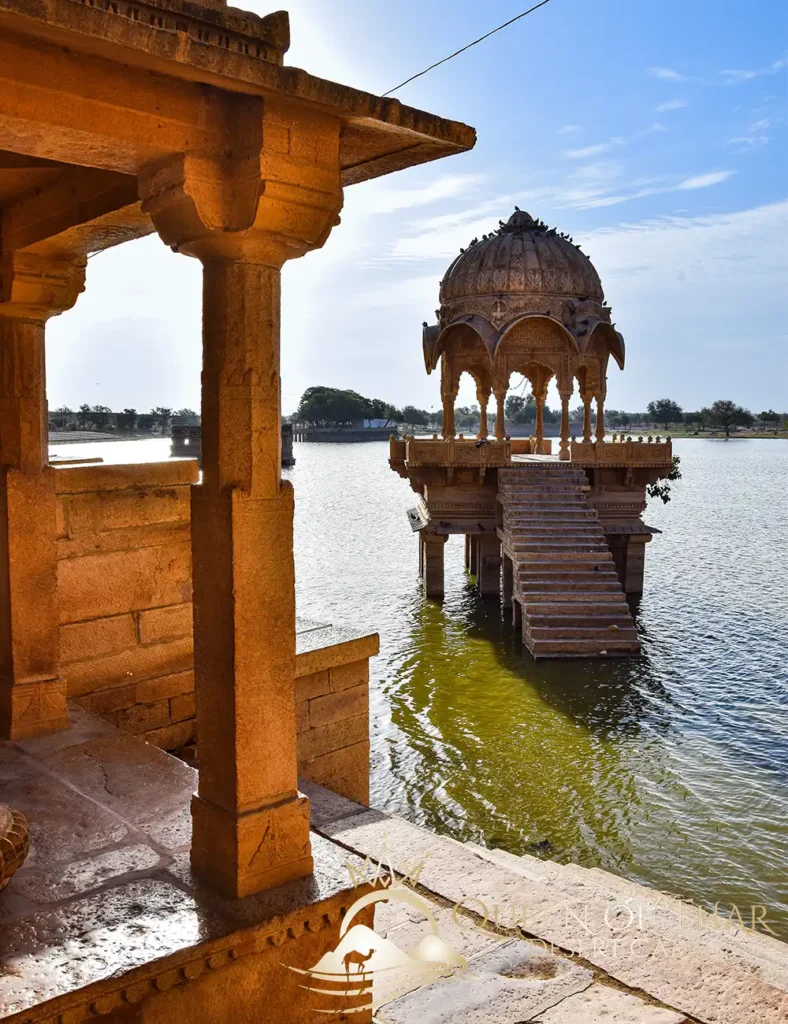

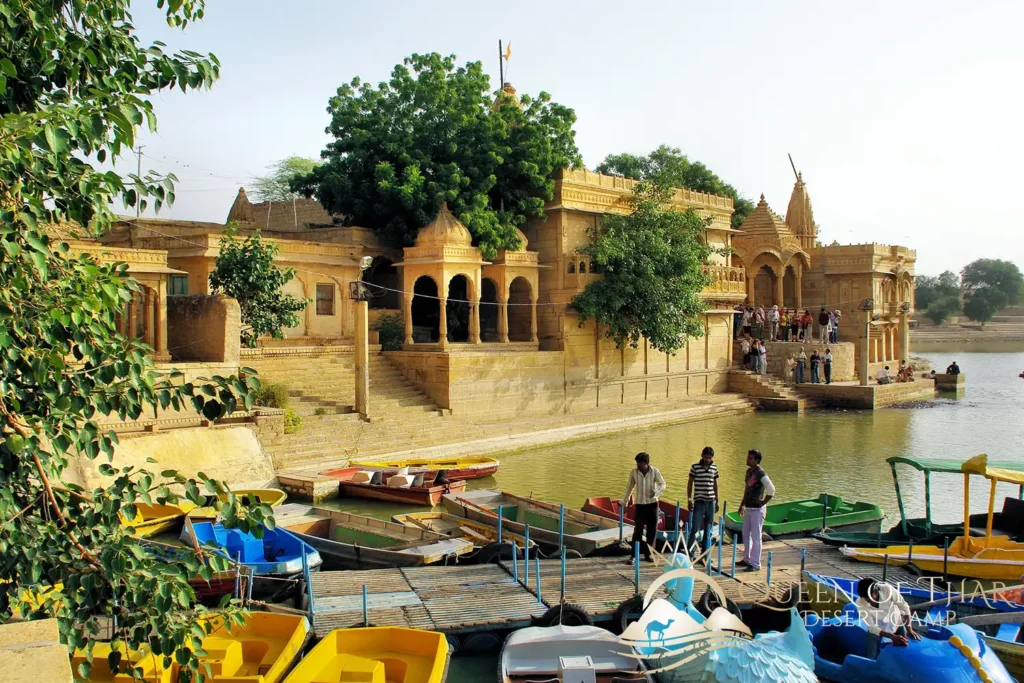

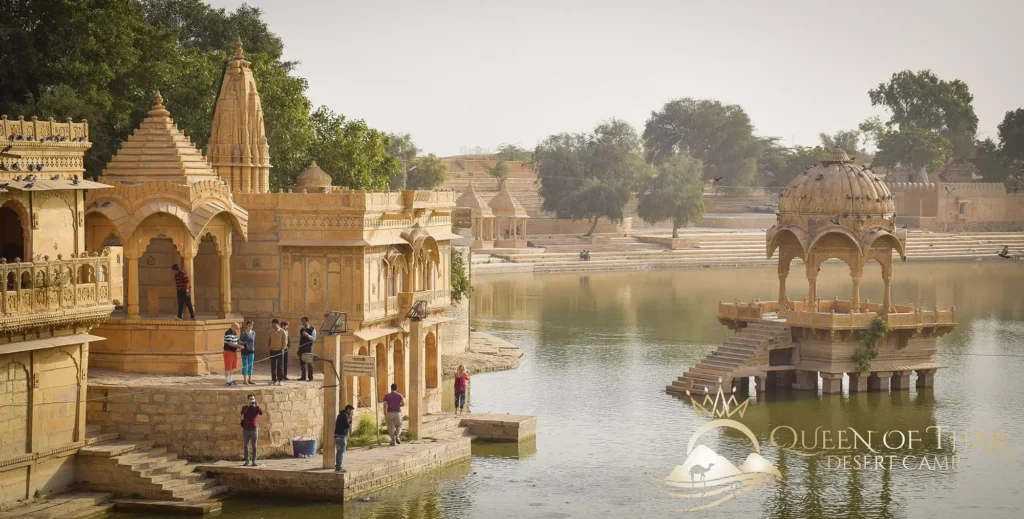
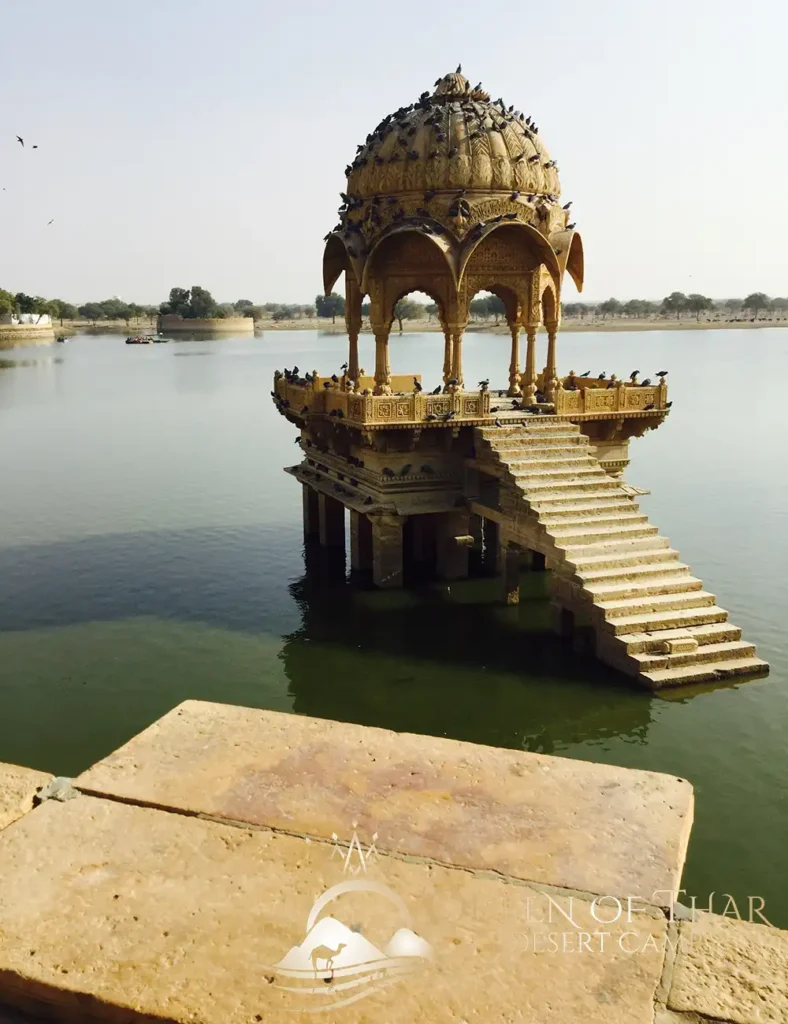
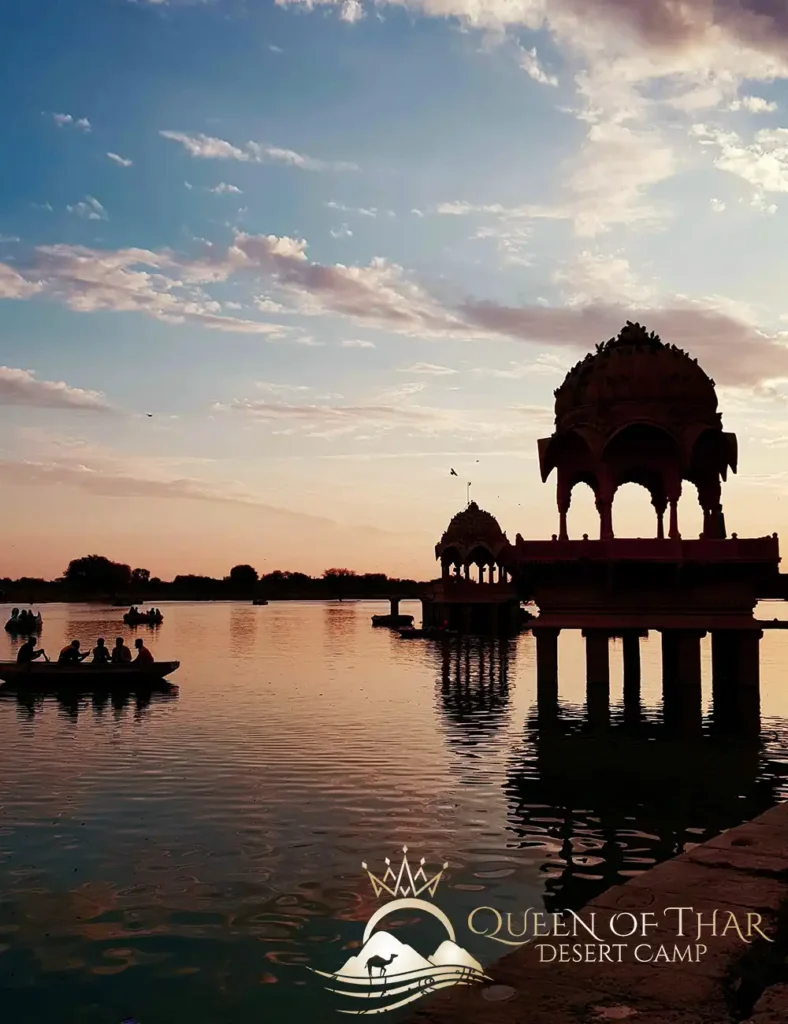
Next on our list of places to visit in Jaisalmer is the lovely Gadisar Lake, located to the south of Jaisalmer Fort quite close to town. The lake sits like a gorgeous oasis in the desert – the calm waters of the lake surrounded by golden sandstone ghats (steps), temples, cenotaphs, and shrines, creating a captivating sight. The lush greenery and trees surrounding the lake providing a refreshing contrast to the arid surroundings. It is a popular rest spot, owing to its cool and scenic surroundings.
The magnificent monuments, which surround the lake manifest the alluring art and architecture of the golden city of Jaisalmer. The entrance to the lake is marked by beautifully carved yellow stone archway (known as Tilon ki Pol) built by a royal courtesan of the 19th century.
Beautiful as it is today, adorned with its many chhatris or cenotaphs of past rulers and with intricately carved shrines dedicated to Hindu Gods and goddesses, the origins of the lake are less glamourous. It is an artificial lake originally constructed in around the 12th century as a water catchment and used to supply water to the residents inside the city and fort through a system of canals.
Today Gadisar Lake is not only a historical and cultural attraction but also a recreational and leisure destination. One of the most most popular tourist activities at Gadisar Lake is boating. Visitors can choose from different types of boats such as row boats, paddle boats and shikara rides. Walking, photography and picnicking are also popular. So too is bird watching, with the lake attracting many migratory birds from different parts of the world every year, including exotic birds such as pelicans, flamingos, cranes, ducks and geese.
Akal Wood Fossil Park
For a visitor travelling further to the south west from the Gadisar Lake and with an interest in geology, there is the Akal Wood Fossil Park, a National Geological Monument of India and a Biodiversity Heritage Site, around 17 KM away from Jaisalmer city, on a stretch of about 10 km of bare hillside. The area used to be a forest about 180 million years ago. Although hard to imagine now, over time the region was submerged under the sea and the tree trunks on display today are the remnants of that era which became petrified during the breakup of the Gondwana supercontinent. The site contains fossils of Pterophyllum, Ptilophyllum and other remnants of the Early Jurassic period.
Places to visit in Jaisalmer City
Jaisalmer Fort


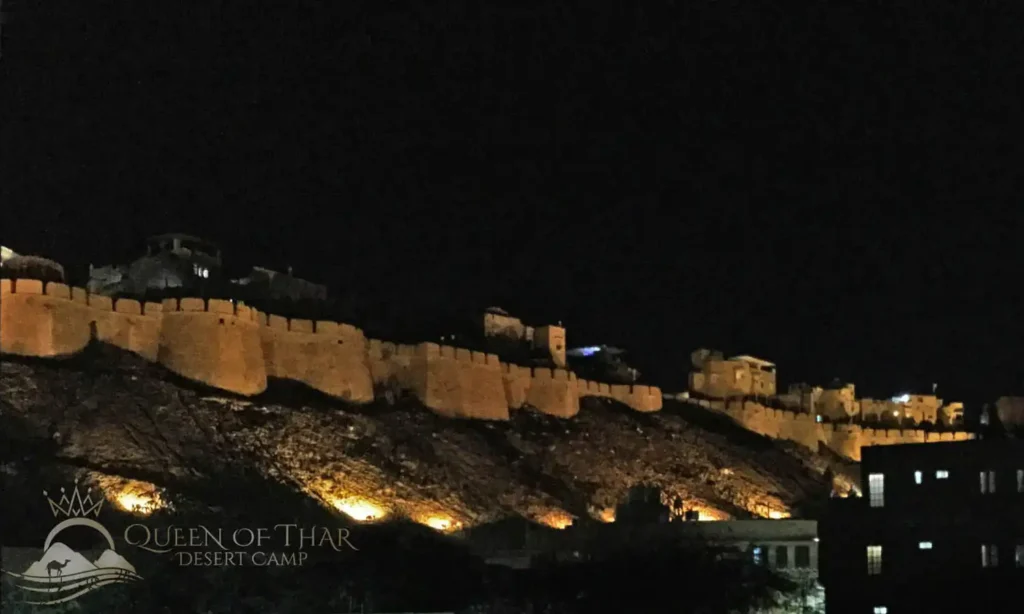

Of course no visit to the golden city of Jaisalmer is complete without a trip to see the iconic Jaisalmer Fort, also known as the Golden Fort because of its distinctive golden sandstone walls that glow in the sun. It is one of the largest fully preserved fortified cities in the world and the most popular tourist attraction to visit in Jaisalmer. The fort stands atop Trikuta Hill and has offered panoramic views of the surrounding desert for over 10 centuries.
Jaisalmer Fort was founded by Jaisal Singh (popularly known as Rawal Jaisal) in 1156 CE. Jaisalmer is named after its founder, with “Jaisal” representing the king’s name and “Mer” signifying a fort. So, it means “The Fort of Jaisal”, emphasising the city’s historic fortification and its royal heritage. It was strategically constructed to serve as a stronghold and protect the kingdom from invasions. It took Jaisal 7 years to complete, with a fortification wall around 5 km in length and 2-3 metres thick and 2 main fort walls running parallel.
Jaisalmer Fort has witnessed numerous battles including clashes between the Bhati Rajputs and rival kingdoms. Despite this, the fort has remained unconquered throughout its history.
Jaisalmer Fort was an important trading hub, strategically constructed on the crossroads of historic trading routes, including the Silk Road, connecting India with Central Asia and beyond. With the fort providing security, Jaisalmer flourished from the network of regional trade caravans. Over the centuries, the fort evolved into a thriving city within its walls. Rich merchants built intricately carved havelis in the fort, adding to the beauty and charm of the “Golden City.”
Today, Jaisalmer Fort is a UNESCO World Heritage Site and remains inhabited, with a significant portion of the population residing within its walls. It houses several palaces, including, 7 Jain temples, museums and rooftop cafes. It is at the top of the places to visit in Jaisalmer.
The Fort’s Maharaja’s palace
Places to see inside the fort include the Maharaja’s Palace, (Raj Mahal Palace) the former residence of the Jaisalmer rulers. Those in charge of restorations have converted the palace into a modern museum, housing carefully preserved artefacts from the times of old. Visitors can explore the various rooms, from the King’s bedroom, audience room, and the sweeping main terrace which offers enchanting views of the city below.
Other things to see in Jaisalmer Fort are Surya Gate, Laxminath Temple, markets, bazaars and street performers, narrow lanes and tight cobblestone steps. In the main square of the fort, called Chauhata Square, you will find eager tour guides, street performers, markets, and a bustling mix of residents and visitors going about their day.
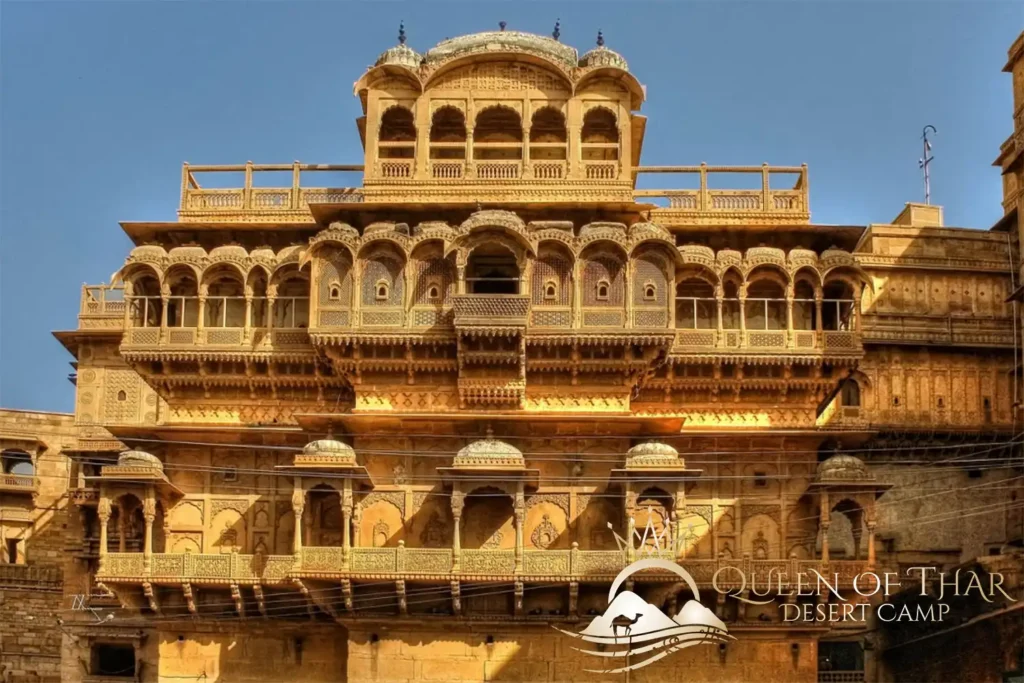
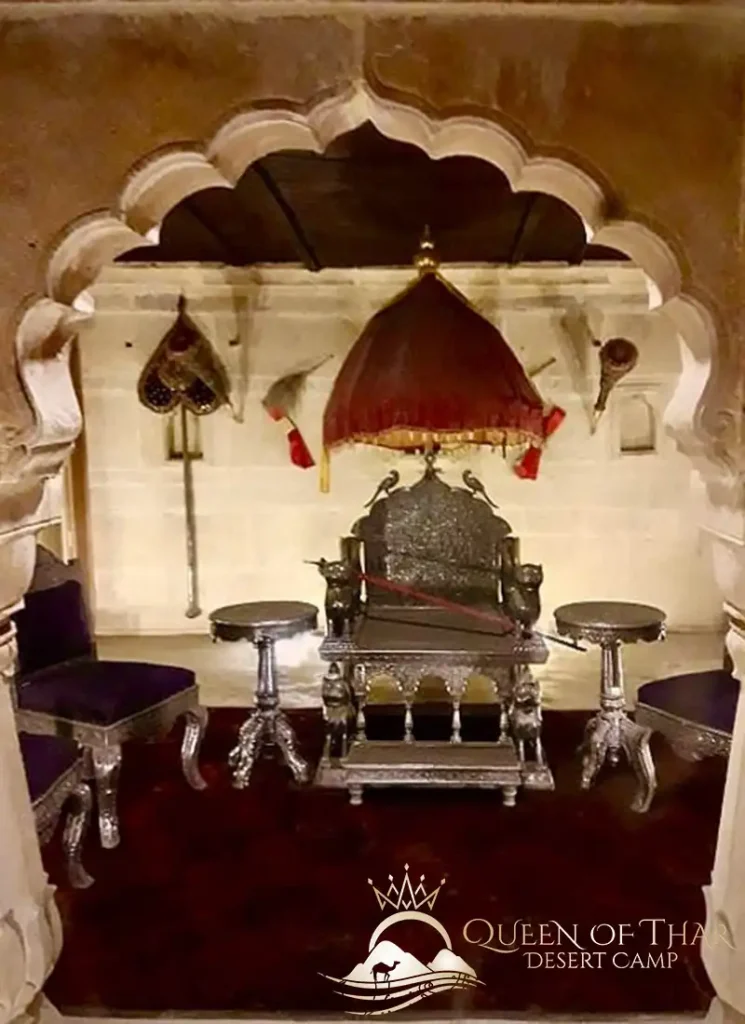

The Jaisalmer Fort of Rajasthan truly lives up to its name as a living fort. As you wander the laneways and streets in search of the next highlight or attraction, you’ll pass dozens of markets, handicraft storefronts, artists and talented street performers, as well as local folk/residents going about their daily tasks. It is a real, breathing community.
Jaisalmer Fort is located around 2 km away from Jaisalmer railway station.
Jain Temples at Jaisalmer Fort
Other places in Jaisalmer Fort to see include the seven Jain Temples dedicated to various Jain Tirthankaras or spiritual leaders. The temples are built in the Dilwara style of architecture and are adorned with intricate carvings, sculptures and paintings.

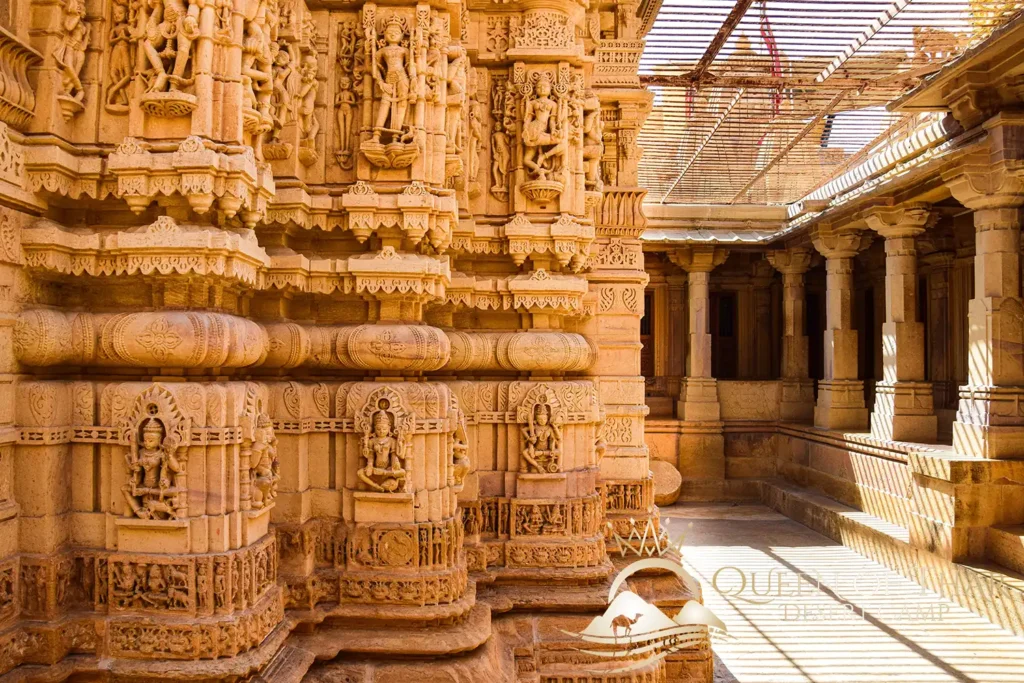
One of the most noteworthy features of the Jain temples within the Jaisalmer Fort is the intricate marble carvings. The temples boast finely detailed sculptures, delicate patterns and ornate designs. The exquisite carvings depict scenes from Jain mythology, Tirthankaras and various divine motifs, making these temples not only religious sanctuaries but also artistic masterpieces. The level of detail in the marble work is a distinctive and captivating aspect of the Jain temples within Jaisalmer Fort.
The temples are considered to be among the most beautiful and sacred Jain temples in India. The most impressive Jain temple within the citadel complex is the Parsvanath Temple.
Jaisalmer’s Havelis
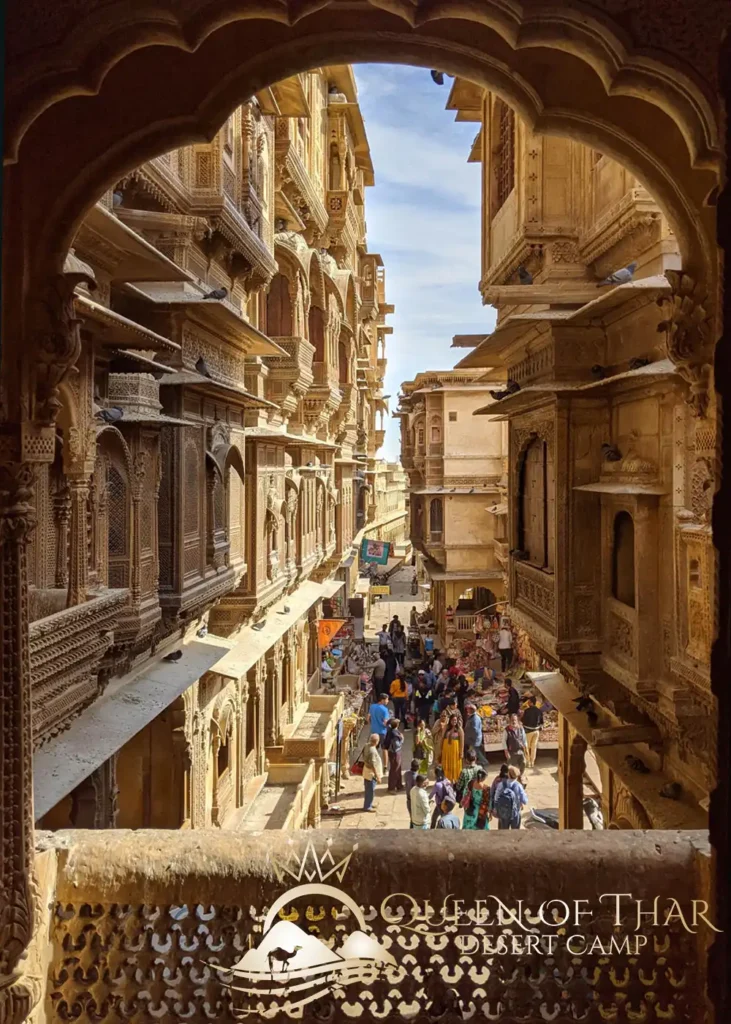
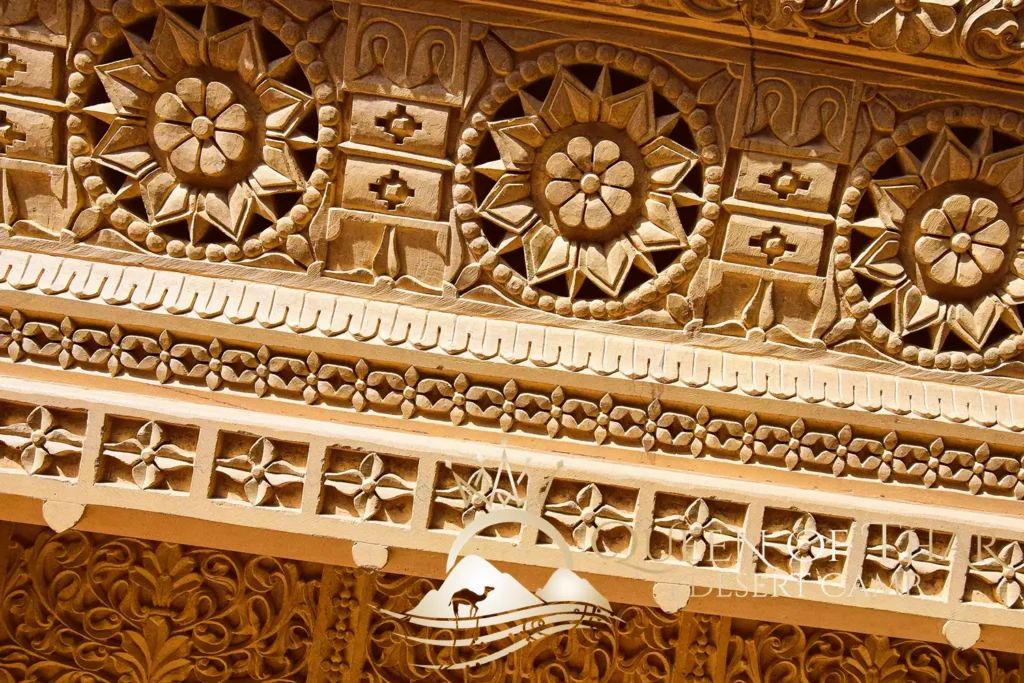
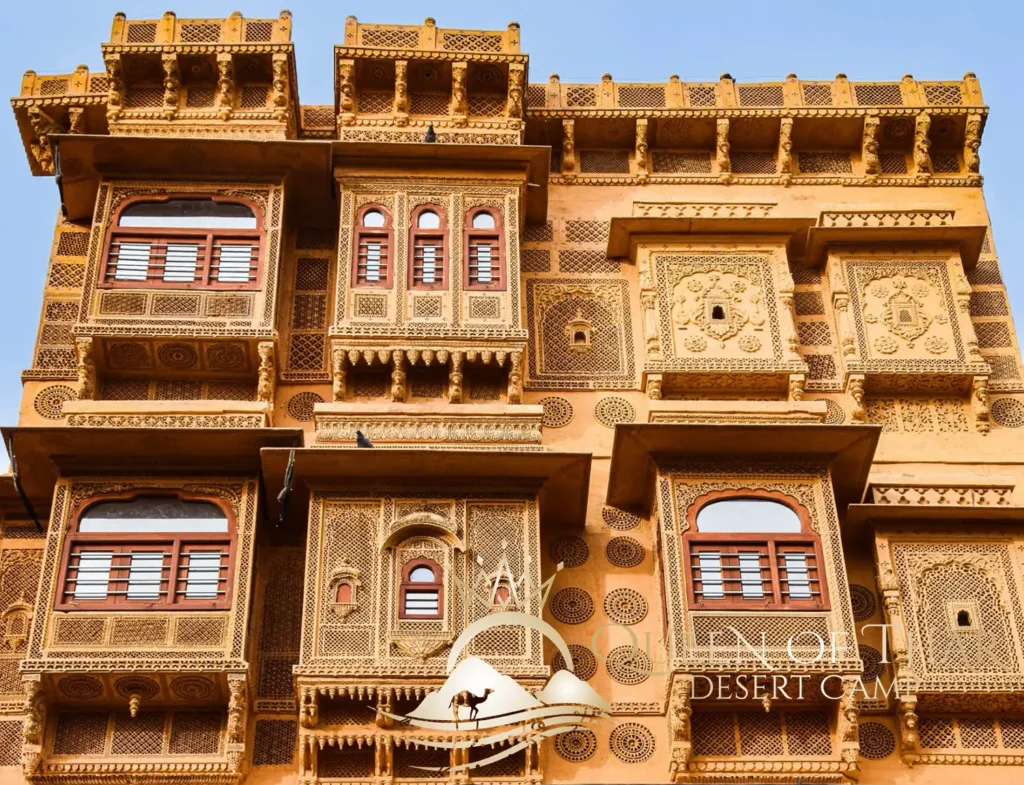

The best places to visit in Jaisalmer city itself also include its exquisite havelis that showcase intricate architecture and opulent craftsmanship. These havelis stand as architectural gems, reflecting the grandeur of a bygone era.
An haveli is a traditional multi-story Indian townhouse or mansion, built by wealthy aristocratic families, merchants or rulers. The word ‘haveli’ is derived from Arabic ‘hawali’, loosely meaning “private space” and although their style varies from region to region they are characterized by ornate facades, intricate carvings, and spacious courtyards historical and architectural significance.
Patwa Ki Haveli Jaisalmer
One of the most famous Jaisalmer havelis is known as Patwon Ki Haveli Jaisalmer, which was built by a wealthy merchant, Guman Chand Patwa, and his sons, in the 19th century. The Patwon Ki Haveli are also known as the Mansion of Brocade Merchants, because the Patwa family traded in gold and silver threads for ladies’ dresses. The haveli is actually a cluster of five mansions, each adorned with intricate carvings and balconies, each with its own distinctive features and decorations.
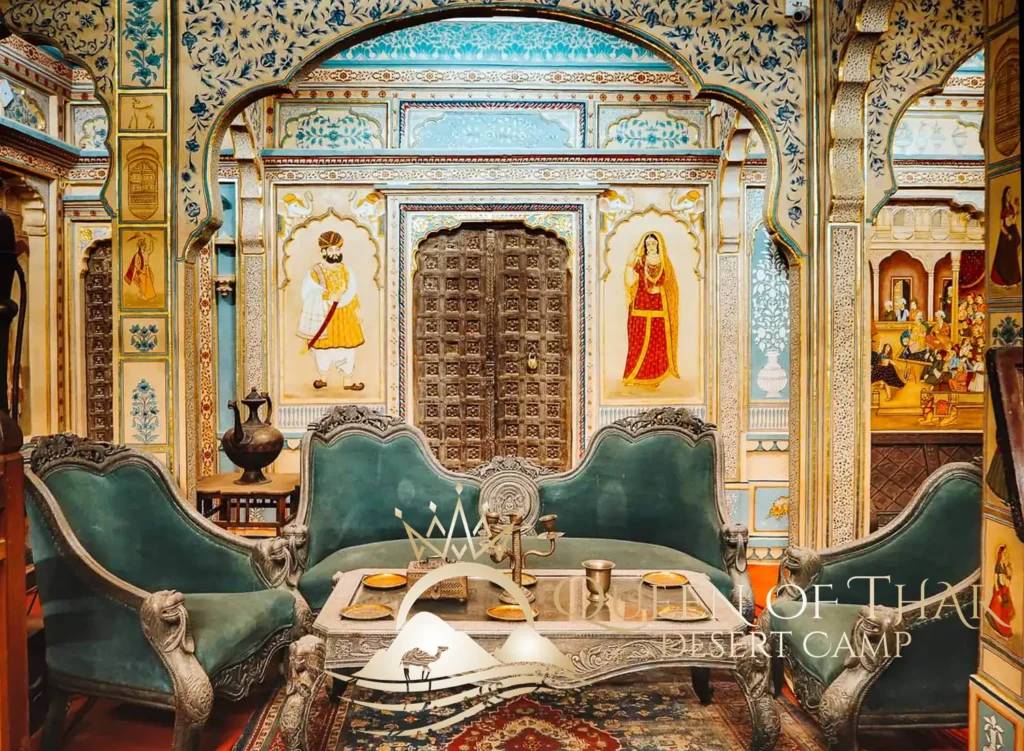

The Patwon Ki Haveli is famous for the exquisite craftsmanship, including mirror work, frescoes, latticed windows and balconies. The architecture of Patwa Ki Haveli is recognised as a remarkable example of the traditional Rajasthani style, which features yellow sandstone, intricate carvings, ornate balconies and spacious courtyards. After Jaisalmer Fort, this is one of the top tourist attractions in Jaisalmer city – many people call it ‘The Taj Mahal of Jaisalmer’.
The Patwon Ki Havelis are now open to the public as museums so that visitors can admire the architecture, art, and history of these magnificent buildings. The Kothari’s Patwa Haveli Museum is now a private museum that showcases the history, culture and art of the Patwa family and Jaisalmer. Inside you can have a look at what luxurious life was like back in the Rajasthani days of old – the sumptuous rooms, old fashioned kitchen and beautiful views from their rooftop.
The individual names of the Patwa Ki Havelis are Bahadurmal Ji Bapna Haveli, Sawairam Ji Bapna Haveli, Magniram Ji Bapna Haveli, Johrawarmal Ji Bapna Haveli, and Pratapchand Ji Bapna Haveli. These names correspond to the five sons of Guman Chand Ji Bapna, the patriarch of the Patwa family who have earnt their place in Jaisalmer history.
Salim Singh Ki Haveli Jaisalmer

Salim Singh Ki Haveli, also known as Jahazmahal, is another famous historic mansion located in Jaisalmer city. It was built in the early 18th century by Maharawal Salim Singh II, who served as the then prime minister of the princely state of Jaisalmer.
One of the most distinctive aspects of Salim Singh Ki Haveli is its intricately designed rooftop, which is said to resemble the shape of a peacock. The curvilinear shape and ornate balconies of the haveli’s upper floors resemble the wings of a bird. These balconies are adorned with exquisite carvings and lattice work and the walls and balconies are all covered with imperial paintings.
Nathmal Ki Haveli Jaisalmer
The Nathmal Ji Ki Haveli is a privately owned haveli in Jaisalmer city, around half a KM away from the golden fort. This haveli is regarded as a perfect example of the beautiful fusion of Islamic and Rajputana styles of architecture. Built in the 19th century by two architect brothers who started the construction from opposite ends, this palace has similar but non-identical left and right facades. This choreographed asymmetry adds to the architectural beauty of the haveli.
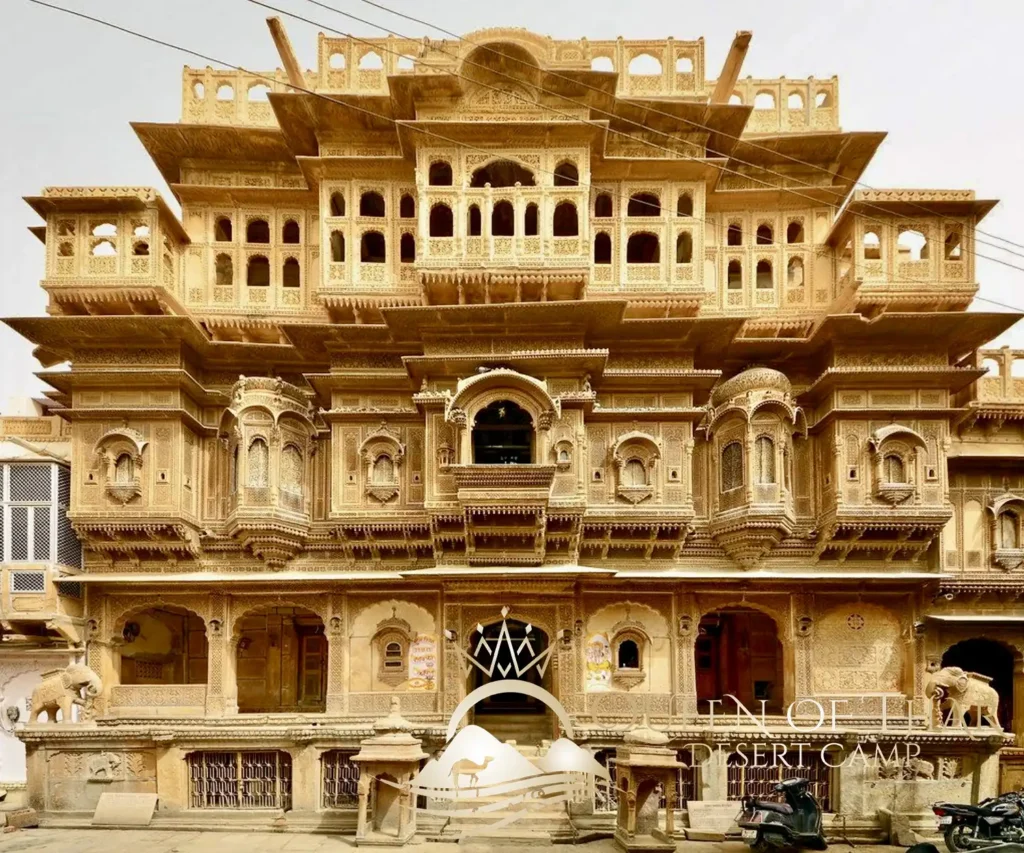
The haveli’s façade is adorned with meticulously crafted stone carvings depicting various motifs, animals and intricate patterns, and the building is renowned for its delicate lattice work. Miniature style paintings and mighty tuskers carved out of yellow sandstone were used for decorating the inner chambers of the mansions.
The Tasia Tower

Another of the places to visit in Jaisalmer close to the fort is the Tazia Tower, a five-storied structure that built by Muslim craftsmen in the 19th century. It is another remarkable example of Rajput and Islamic architectural fusion. It is famous for its beautiful blend of various architectural styles, with ornate balconies, canopies and intricately carved screens. It is part of the Mandir Palace, which is a now a heritage hotel.
Each of the five stories of Tazia Tower represent a different architectural style and it is topped with a uniquely designed wooden balcony from which visitors can enjoy views of the golden city. The tower is particularly known for its finely crafted balconies, intricately carved facades and the cultural significance it holds during the annual Muharram procession, where colourful Tazias (decorated replicas of mausoleums) are paraded through the city.
The Tazia Tower and Mandir Palace are located close to the Jaisalmer Railway Station.
Apart from sightseeing and adventure, how can I experience the real cultural heritage and lifestyle of Jaisalmer?
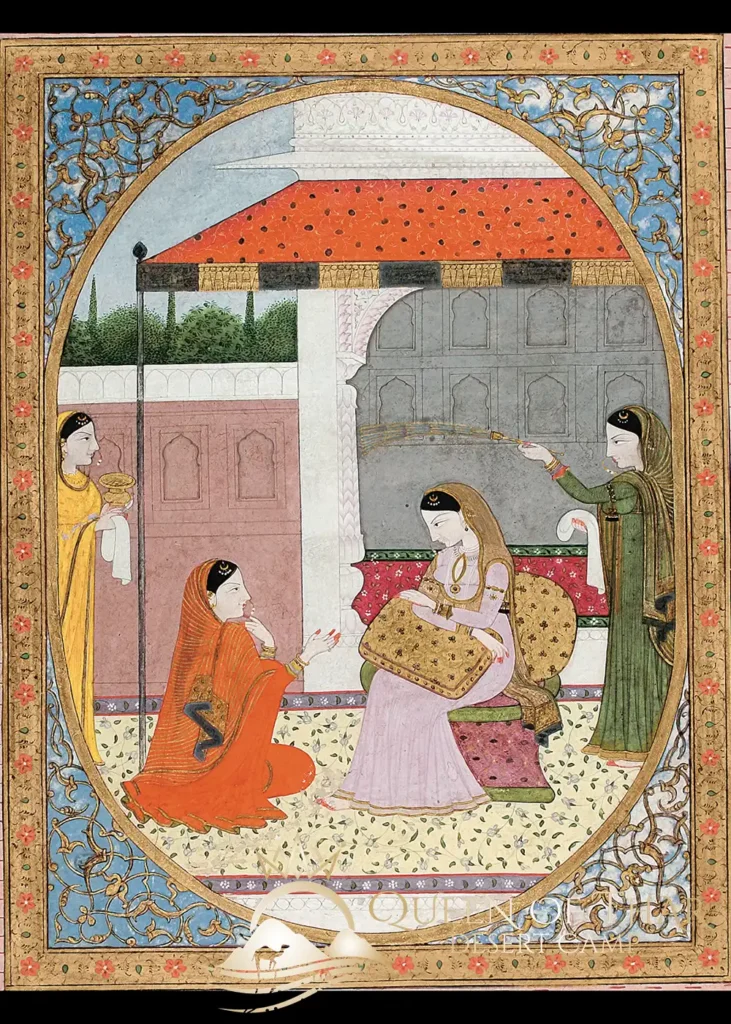





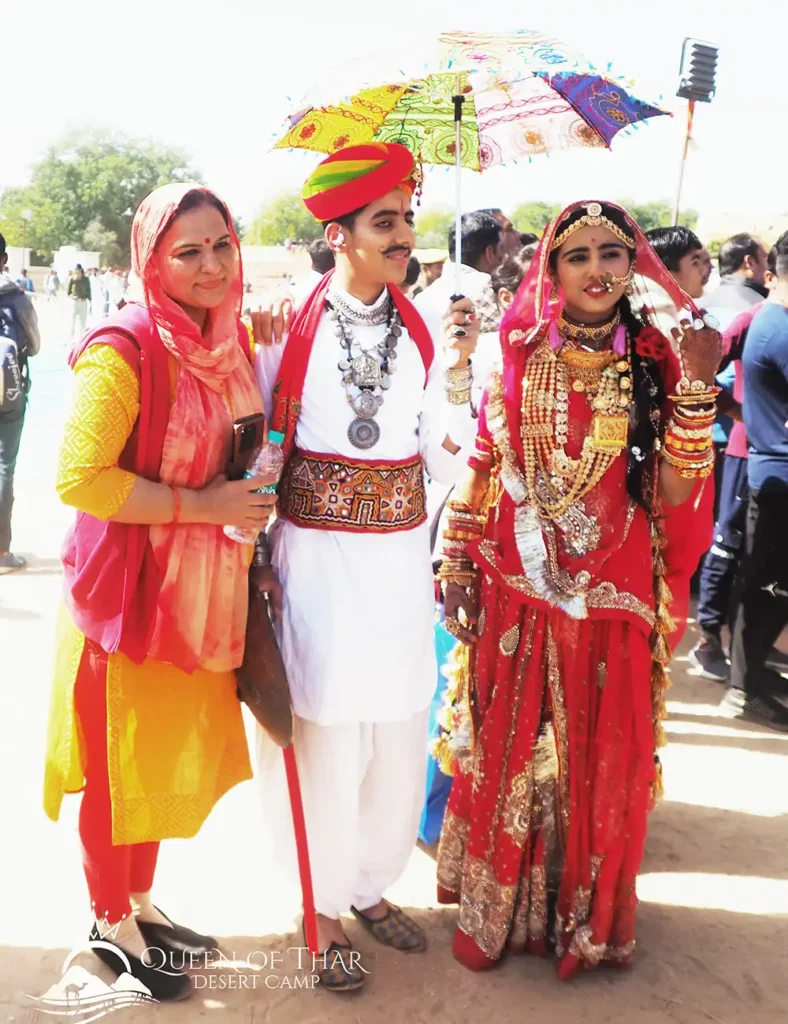




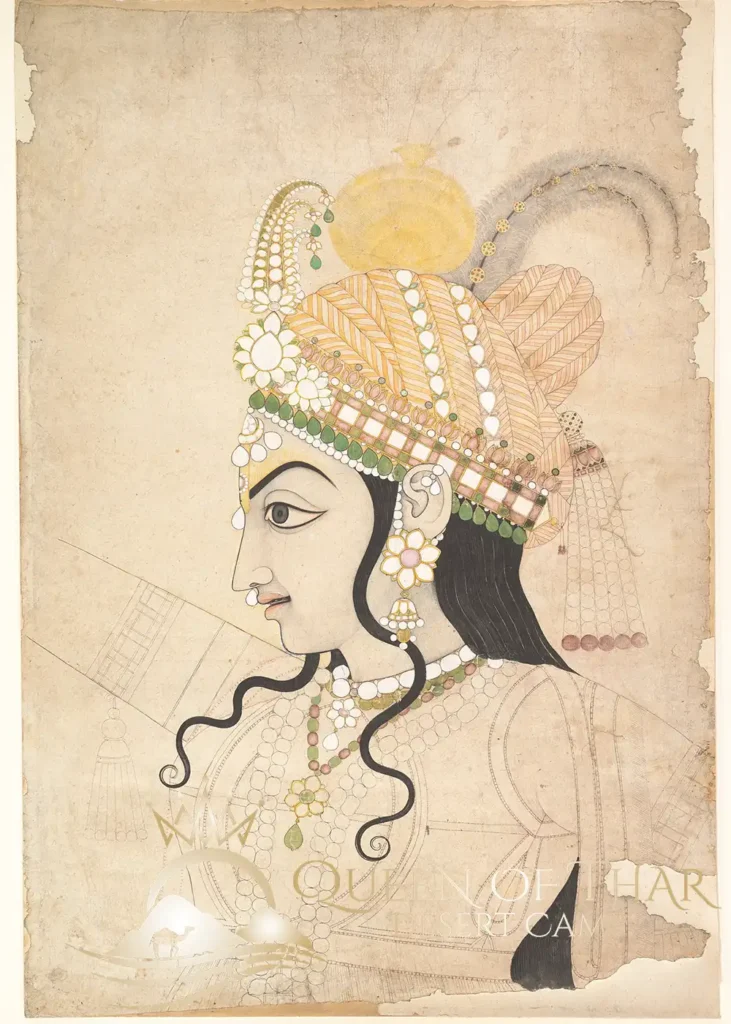
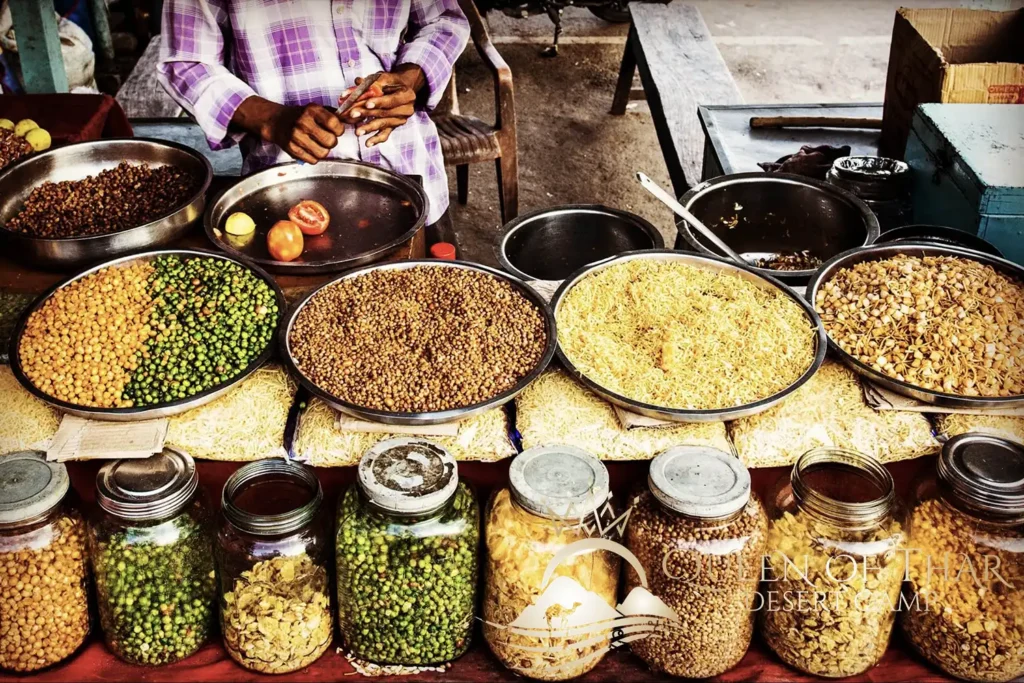



Jaisalmer is a city that has an enormously rich and diverse cultural heritage and lifestyle, influenced by its history, geography and people. The city’s lifestyle is significantly influenced by its desert surrounding and the fusion of Rajput and Islamic traditions, following the establishment of the Delhi Sultanate and Mughal Empire in northern India.
Some of the ways you can experience the culture and heritage are:
- Participate in a local festival, like the Desert Festival, a three-day annual event that showcases the folk art, music, dance and cuisine of Jaisalmer. You can witness the colourful costumes which all come out for the costume competitions, the camel races, the fire dances, the turban tying competitions and the puppet shows. The festival is usually held in February near the Sam Sand Dunes.
- Listen to a concert, where skilled musicians play traditional Rajasthani instruments such as the Kamaicha, a 400-year old stringed instrument, and the Algoza twin flutes that are played simultaneously by one person – a very impressive feat requiring considerable skill and which the local people are justly very proud.
- Browse through the vibrant local markets in and around the golden fort like Manak Chowk, Pansari Bazaar, Sonaron Ka Baas, Bhatia Bazaar and Sadar Bazaar. Shop for handicrafts and bargain for the best prices. Check out the colourful local textiles in the Desert Art Gallery and camel leather items in the street stalls. You can find a variety of items, such as mirror work, embroidery, leather, silver, carpets and puppets, that reflect the art and skill of the local artisans.
- Given its desert location, camels play a significant role in Jaisalmer’s lifestyle. Camel safaris providing an opportunity to explore the vast Thar Desert and experience the nomadic lifestyle associated with camel herding.
- Stay in a desert camp near Sam Sand Dunes, a traditional way of living in the Thar Desert. Enjoy the rustic and authentic experience of sleeping in a tent, riding a camel on a camel safari, watching the sunset and gazing at the stars. Also enjoy the local food, music and dance.
- Enjoy a cultural program at a desert camp, giving a different taste of nightlife, enjoying the folk music of the Jaisalmer region with local artists every evening and the exotic taste of local cuisine. At Queen of Thar, the show includes tribal dances, including Kalbeliya, Bhavai Chakri (balancing clay pots) and fire dancing, music performed with traditional instruments such as the Kamaicha. Finish your evening with a delicious Rajasthani meal.
- Visit the museums and galleries including Thar Heritage Museum, which displays the region’s unique heritage through folk art and artifacts, and Kothari’s Patwa Haveli Museum, which showcases a collection of artifacts, paintings and textiles from the 19th century. The Jaisalmer Fort Palace Museum is a treasure trove of historical artefacts and cultural relics and together with the Jaisalmer Government Museum you can learn about the history and legends of Jaisalmer, and the many wars, invasions, and migrations it has witnessed. You can also visit the Baa Ri Haveli Museum, the silk route art gallery, Vyas Chhatri, Khuri sand dunes and the Jaisalmer Folklore Museum & Desert Cultural Centre and many other tourist places in Jaisalmer.
- See the golden sandstone architecture Jaisalmer is renowned for. The intricate carvings, ornate havelis and ancient temples showcase the artistic prowess of the region. You can visit the the monuments, the cenotaphs, and the war memorials, and listen to the tales of bravery, romance and mystery.
- Enjoy the local cuisine which reflects the desert lifestyle, with a focus on locally sourced ingredients. Traditional Rajasthani dishes like Dal Baati Churma and Laal Maas are popular, and the cuisine often incorporates a variety of spices and pulses.
Jaisalmer, like many other Rajput regions, has a rich tapestry of folklore and stories that are often passed down through generations. Listen to local stories that contribute to the cultural identity of Jaisalmer, preserving the history, valour and romanticism associated with the Rajput tradition. They are often shared during local festivals, cultural events and storytelling sessions, continuing to captivate both residents and visitors alike.
These are some of the ways to experience the real cultural heritage and lifestyle of Jaisalmer.
When is the best time to visit Jaisalmer?
The best time to visit Jaisalmer is during the winter season, from October to February. This is when the weather in Rajasthan is pleasant and the sand in desert around Jaisalmer and Sam Sand Dunes is not too hot.
During the summer season, from April to September, it is very hot and dry and can be exhausting for tourist. In the desert, the temperature can soar up to 50°C and the sun and sand can burn your skin, so it is not the best time to visit, particularly if you are going on a desert safari in Sam Sand Dunes.
How do I get there?
Jaisalmer is well-connected by road, rail and air from major cities of India. During the tourist season (around October to February), you can fly directly to Jaisalmer. At other times, you can take a flight to Jodhpur in Rajasthan and then hire a taxi or take a bus to reach Jaisalmer. Alternatively, you can take a train to Jaisalmer railway station.
From there, to travel to these places to visit outside of the city you can hire a car, or if you are staying at Queen of Thar Desert Camp, the camp can arrange your pickup from Jaisalmer, or the airport, and transfer you to Queen of Thar Desert Camp. The desert camp is on the edge of Sam Sand Dunes and the dune bashing adventure sets out from there, as do the camel desert safaris. For further information on how to get there, please contact us.
© 2024 “Queen of Thar All rights reserved
